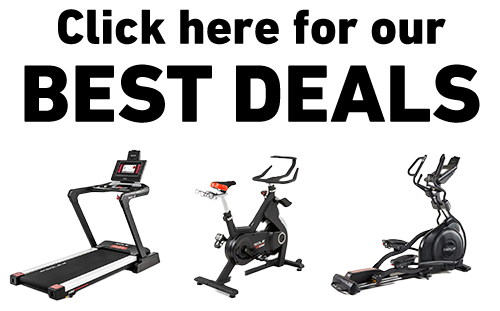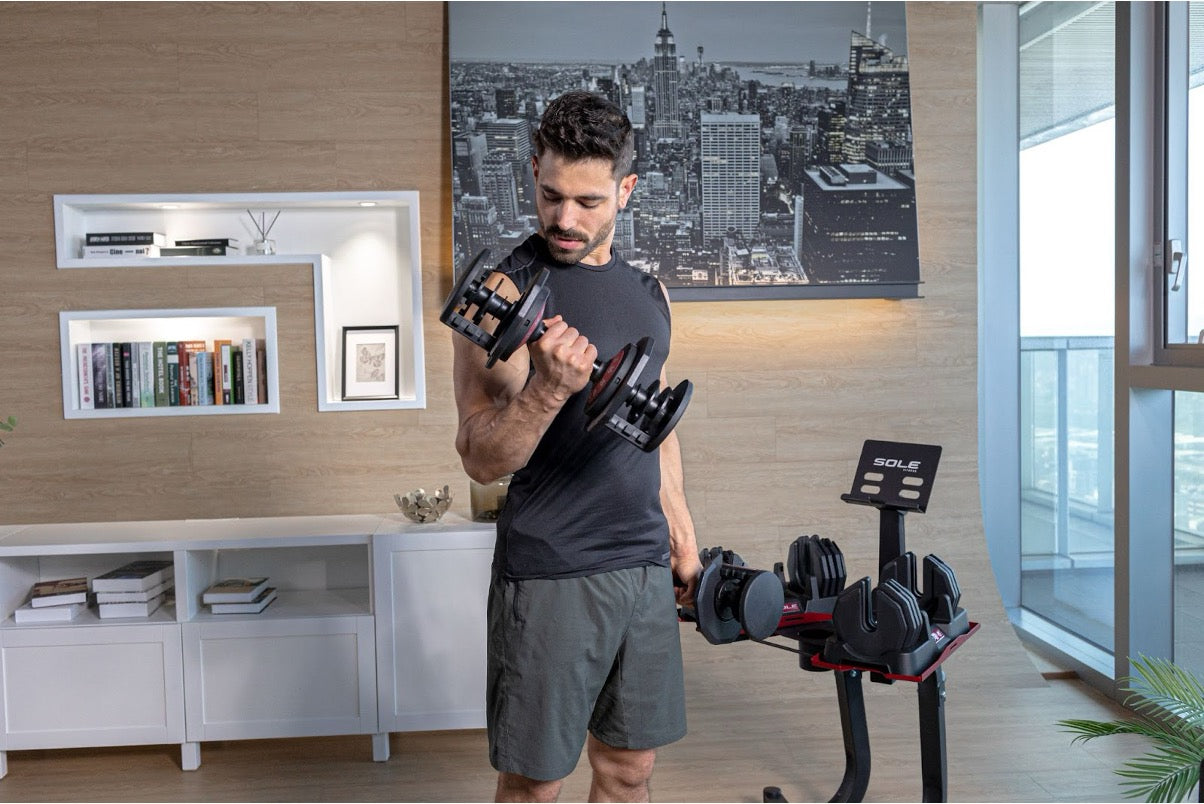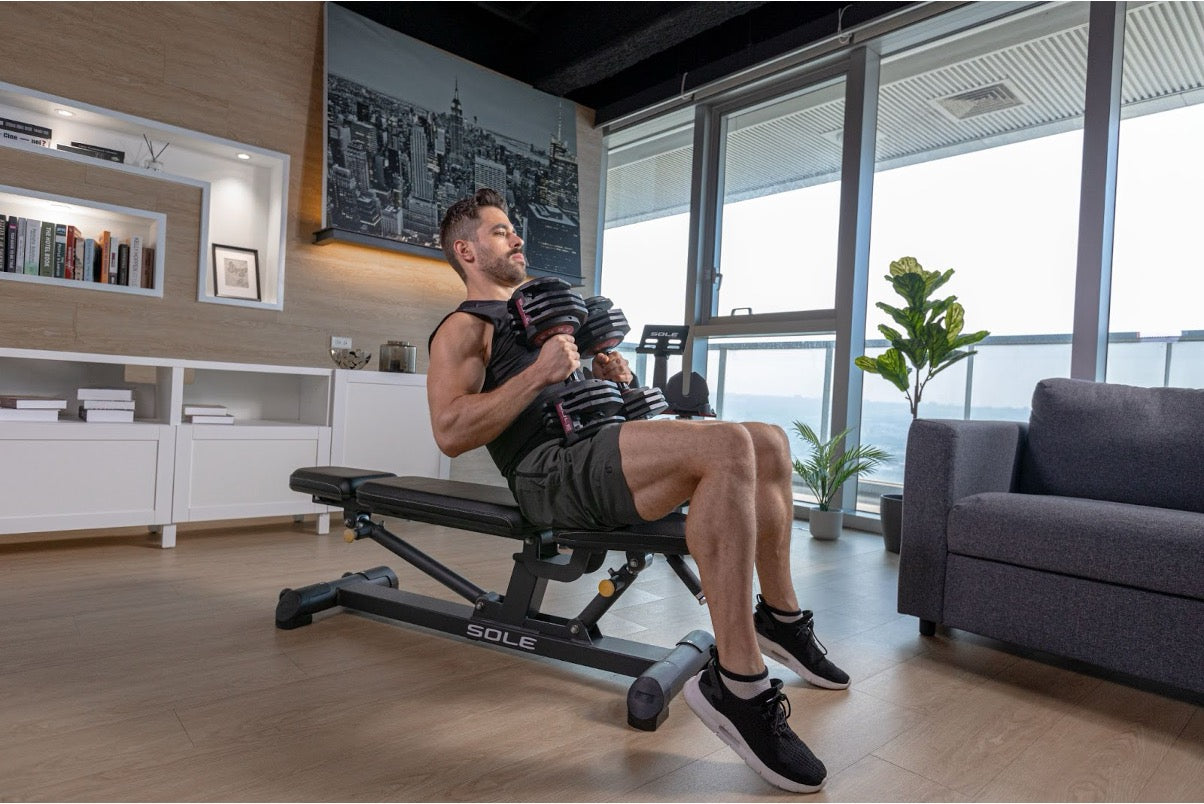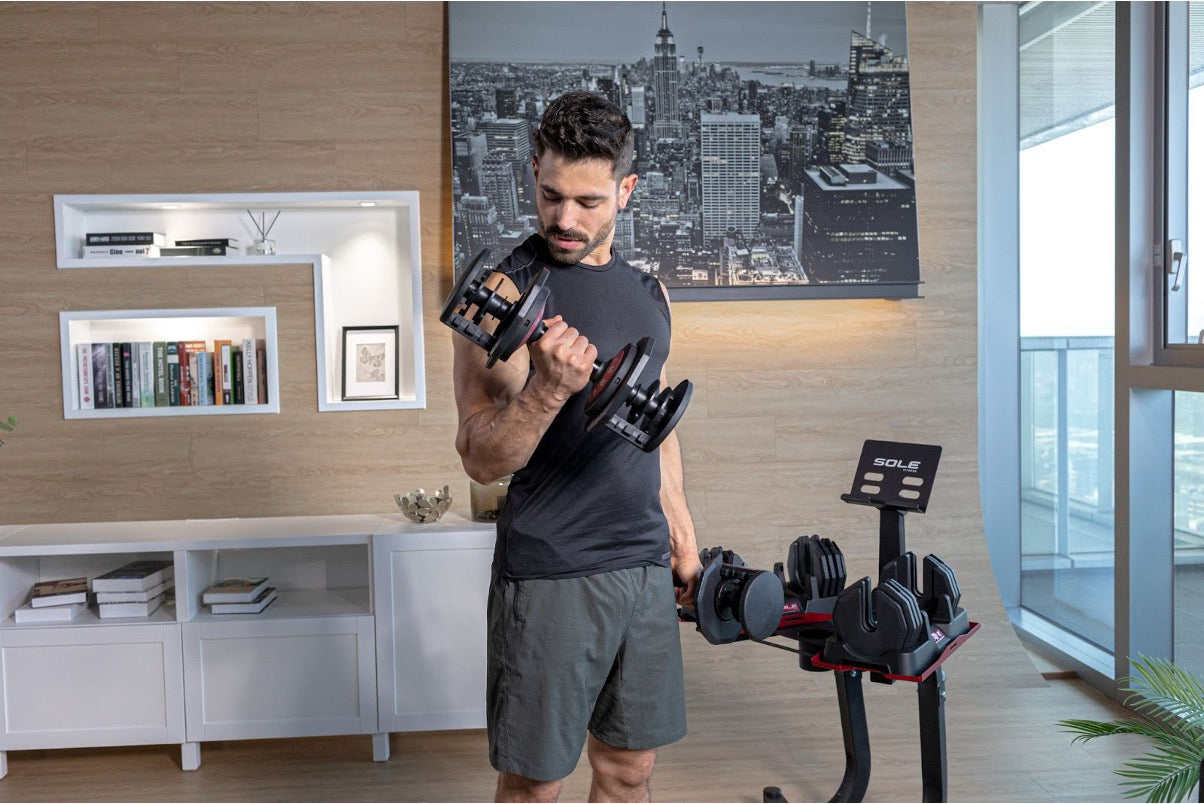Key Takeaways
- Strong middle delts give you rounded shoulders, prevent injuries, and improve overall strength
- Dumbbells work better than machines because they allow natural movement and fix muscle imbalances
- Top exercises include Lateral Raises, Arnold Press, Bent Arm Raise, Dumbbell Row, and L-Raise
- Focus on good form, do 3-4 sets of 8-12 reps, train 1-2 times weekly, and don't skip rest days.
- Here at Sole Fitness, our dumbbells help you crush your fitness goals pain-free with quick-change weight settings, perfect balance, and comfortable grips that make every strength session smooth and easy on your wrists.
Middle Delt Focus Points
The middle deltoids, or middle delts, are the muscles that give your shoulders that rounded, full appearance. They're essential not just for aesthetics but also for the functional movement of your arms.
When these muscles are strong, they help stabilize your shoulder joint, reduce the risk of injury, and improve your overall upper body strength.
Most importantly, when you train your middle delts, you're working towards a balanced physique. Nobody wants to have strong arms and a weak shoulder, right?
That’s why focusing on these muscles will give you that symmetrical look, enhancing your overall appearance.
|
At SOLE, we're proud to offer top-quality exercise equipment designed for home and gym use. Our machines are built to meet the highest standards of durability and performance, making them ideal for fitness enthusiasts at any level. SOLE Products
|
Benefits of Dumbbells for Training Middle Delts
Now, let's talk about why dumbbells are awesome for training your middle delts. They give you way more freedom to move than machines do. This means you can hit those muscles just right and get better results.
Dumbbells allow for a more natural movement pattern, reducing the strain on your joints and promoting muscle growth.
Plus, dumbbells help fix muscle imbalances. Since each arm works on its own, both sides get an equal workout. This is super important to avoid having one side stronger than the other, which could lead to injuries down the road.
Another cool thing about dumbbells? They're super versatile! You can use them for tons of different exercises, not just for shoulders but for your whole body. They're a budget-friendly way to get stronger without needing a bunch of fancy equipment.
Top 5 Dumbbell Exercises for Middle Delts
1. Lateral Raise
The lateral raise is a classic exercise for targeting the middle delts. It's simple, but don't let that fool you—this move is incredibly effective. Here's how you do it:
Start by standing with your feet shoulder-width apart and a dumbbell in each hand. Keep your arms at your sides with a slight bend in your elbows. Raise the dumbbells out to the sides until your arms are parallel to the floor.
Hold for a second, then slowly lower them back down. Remember to keep your core engaged and your movements controlled.
2. Arnold Press
Named after the legendary Arnold Schwarzenegger, the Arnold Press is a fantastic way to hit not only your middle delts but also the front and rear delts. It's a comprehensive shoulder workout in one move.
To perform the Arnold Press, sit on a bench with a back support and hold a dumbbell in each hand. Start with your palms facing your body and elbows bent. As you press the weights overhead, rotate your palms to face forward (image courtesy of Men’s Health).
Reverse the motion as you lower the weights back to the starting position. This twisting motion targets the entire shoulder complex, making it a powerhouse exercise.
The best part is that you can also use Arnold Press to strengthen your front delts!
3. Bent Arm Raise
The bent arm raise targets your middle delts while reducing the strain on your elbows. It's a great alternative to the lateral raise.
To do this exercise, stand with your feet shoulder-width apart and hold a dumbbell in each hand. Bend your elbows at 90 degrees and raise your arms to the sides until your elbows are at shoulder height. Lower them back down with control (image courtesy of Women’s Health).
This move is excellent for focusing on the middle delts without overworking the joints.
4. Dumbbell Row
The dumbbell row isn't just for your back; it also gives your middle delts a solid workout. This exercise helps in building that upper body strength and adds definition to your shoulders.
Here's how you can do it: Stand with your feet shoulder-width apart and bend forward slightly at the hips. Hold a dumbbell in each hand with your arms extended toward the floor.
Pull the dumbbells towards your waist, keeping your elbows close to your body. Squeeze your shoulder blades together at the top, then slowly lower the weights back to the starting position. Make sure to maintain a neutral spine throughout the movement.
5. L-Raise
The L-raise is a unique exercise that combines elements of both the lateral raise and the front raise. It's a fantastic way to target the middle delts while also engaging the front delts.
To perform the L-raise, stand with your feet shoulder-width apart and hold a dumbbell in each hand. Start with your arms at your sides (image courtesy of Our Farmer House).
Lift one arm out to the side while simultaneously lifting the other arm in front of you, forming an "L" shape with your arms. Lower them back down and switch sides. This alternating movement ensures both sides of your shoulders get equal attention.
Maximizing Each Exercise
Proper Form
You must maintain proper form to prevent injuries and ensure that you're working the right muscles. When performing dumbbell exercises, keep your core engaged and your movements controlled.
Avoid using momentum to lift the weights, as this can take the focus off your muscles and lead to poor results.
Weight Selection
Choosing the right weight is key. If you're lifting too heavy, you risk compromising your form and getting injured. On the flip side, if the weights are too light, you might not be challenging your muscles enough to stimulate growth.
Start with a weight that allows you to complete your reps with good form but still feels challenging by the last few reps. You should aim to gradually increase the weight as you get stronger.
Reps and Sets
For building strength and muscle, aim for 3-4 sets of 8-12 reps per exercise. This range is typically effective for hypertrophy, which is the process of muscle growth.
If you feel like you can do more reps without losing form, go for it. But if you're struggling to maintain proper technique, it might be time to reassess your weight selection or take a break.
You can also mix up your rep ranges occasionally. For example, you might do a higher rep range with lighter weights for endurance, or a lower rep range with heavier weights for strength.
Workout Tips
Consistency
Consistency is the secret sauce to any fitness journey. It's not about working out intensely for a week and then taking a break for a month. Instead, aim for regular workouts each week. This doesn't mean you have to work out every day, but find a routine that fits your schedule and stick to it.
Even on days when motivation is low, remember that showing up is half the battle. Consistent effort over time leads to significant progress.
Rest and Recovery
Your muscles need time to recover and grow stronger after workouts. Make sure you're getting enough sleep and taking rest days when needed. This will help prevent burnout and reduce the risk of injury.
Remember that rest is not a sign of weakness; it's an essential part of a strong training regimen.
Incorporate active recovery days, where you do lighter activities like walking or yoga, to keep your body moving without overexerting yourself.
Balanced Routine
While focusing on middle delts is great, it's important to have a balanced workout routine that targets all major muscle groups. This ensures that you're developing strength and muscle evenly throughout your body.
Consider incorporating exercises for your chest, back, legs, and core into your routine. This holistic approach will not only enhance your physical appearance but also improve your overall fitness and health.
Lift Smarter, Not Harder with SOLE
Power up without breaking down using SOLE dumbbells.
SOLE dumbbells are a solid choice for taking your home workouts to the next level. The full set includes pairs of 10, 15, 20, 25, 30, 35, and 40 lb. dumbbells—perfect for everything from beginner routines to more advanced strength training.
They’re designed with a rubber-coated hexagon shape that prevents rolling and protects your floors, while the contoured, anti-slip handles give you a confident grip through every rep. Whether you’re doing curls, presses, or flys, these dumbbells are compact, durable, and built for powerful performance.
Check out our SOLE dumbbells now!
Frequently Asked Questions (FAQ)
What is the role of middle delts?
The middle delts, or medial deltoids, play a vital role in shoulder movement and stability. They are responsible for abducting the arm, which means lifting it away from the body. This action is crucial for many daily tasks and sports activities.
Strong middle delts contribute to a balanced shoulder appearance and are essential for maintaining shoulder health and preventing injuries.
How often should I train middle delts?
For optimal results, aim to train your middle delts 1-2 times per week. This frequency allows enough time for recovery while ensuring consistent stimulation for muscle growth.
It's important to listen to your body and adjust your training schedule based on how you feel. If you're experiencing soreness or fatigue, give yourself an extra day of rest before working those muscles again.
Are there bodyweight alternatives?
Yes, there are bodyweight alternatives for training the middle delts, though they may not be as targeted as dumbbell exercises. Push-ups and pike push-ups can help engage the shoulders, including the middle delts.
These exercises are great for when you don't have access to equipment or want to mix up your routine. However, for maximum effectiveness, incorporating dumbbells is recommended.
Can beginners perform these exercises?
Absolutely! Beginners can perform dumbbell exercises for the middle delts - just start with lighter weights to focus on mastering proper form.
As you become more comfortable and confident with the movements, gradually increase the weight to continue challenging your muscles and promoting growth.
SOLE dumbbells are perfect for beginners to start light to master form, then easily adjust the weight as you get stronger. The comfortable grip helps you maintain proper technique while building those middle delts safely.
How do I avoid shoulder injury?
To avoid shoulder injuries, prioritize proper form in all exercises. Warm up adequately before your workout to prepare your muscles and joints for the activity.
Also add stretching and mobility exercises into your routine to maintain shoulder flexibility and prevent stiffness. Most importantly, listen to your body - if you experience pain or discomfort, stop the exercise and consult a professional if needed.




Leave a comment
This site is protected by hCaptcha and the hCaptcha Privacy Policy and Terms of Service apply.